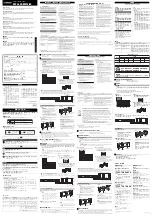
ALC-1809 LOUDSPEAKER CONTROLLER
9
1.2 - CHANNEL MODIFIED INDICATOR
When a DSP setting has been modified on a ALC channel but the changes have not yet been saved to ALC
memory, an asterisk will appear to the right of the channel number. Once the current settings have been saved to
ALC memory, the asterisks will disappear. No asterisks on the front panel display indicates that settings in ALC
memory are “in-sync” with the running DSP programming.
1.3 - INPUT ROUTING
The second display column indicates the analog input currently routed to the ALC output channel (as set up in
SoundWizard™ or SoundTools™ control software, see “ALC Programming”). The source may be any one of the
eight balanced audio input jacks on the ALC back panel or any of four possible summed-mono signals available
in the ALC DSP engine.
From the factory, each output channel is by default routed to its corresponding unbalanced audio input jack. That
is, Output 1 of the ALC is “listening” to Channel 1 balanced analog audio input. Output 2 is routed to the Chan-
nel 2 balanced analog audio input, and so on. Signal routing can easily be changed as required by the system
design via Theory SoundTools™ control software.
1.4 - ADVANCED SETTINGS PRESENT INDICATOR
When advanced controls have been used on a particular channel, a plus sign, “+”, will appear in this column
indicating that there are DSP settings in addition to those shown on the LCD running on the channel in question.
These controls include channel delay, up to five total predefined compensation filters, bass steering, automatic
ducking, and customized parametric EQ. To view these settings, connect the ALC to Theory SoundTools™
software.
1 IN1 SUB15←SUB 1
2*IN1→SUB15 SUB 2 +
LCD DISPLAY
ALC FRONT PANEL
1.1 - CHANNEL NUMBER
1.2 - CHANNEL MODIFIED INDICATOR
1.4 - ADVANCED SETTINGS INDICATOR
1.3 - INPUT ROUTING
1.5 - INSTALLED SPEAKER PROGRAM
1.6 - SPEAKER APPLICATION
1.8 - OUTPUT IS DUCKED INDICATOR
1.7 - INPUT IS DUCKING INDICATOR










































